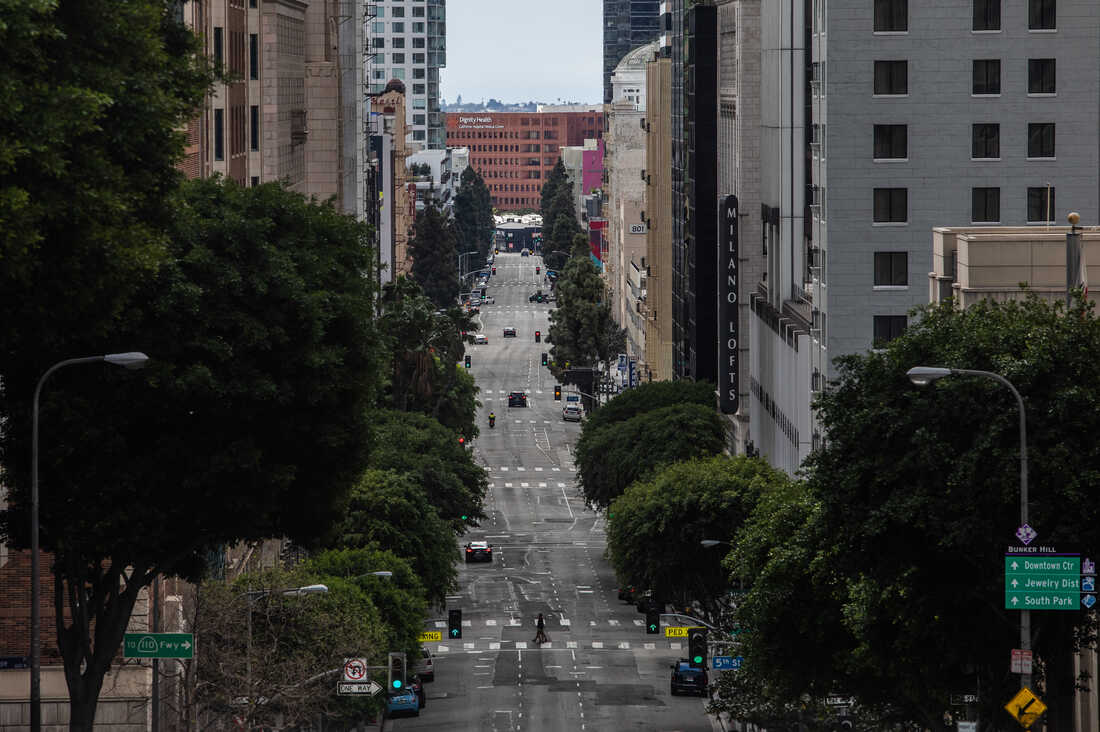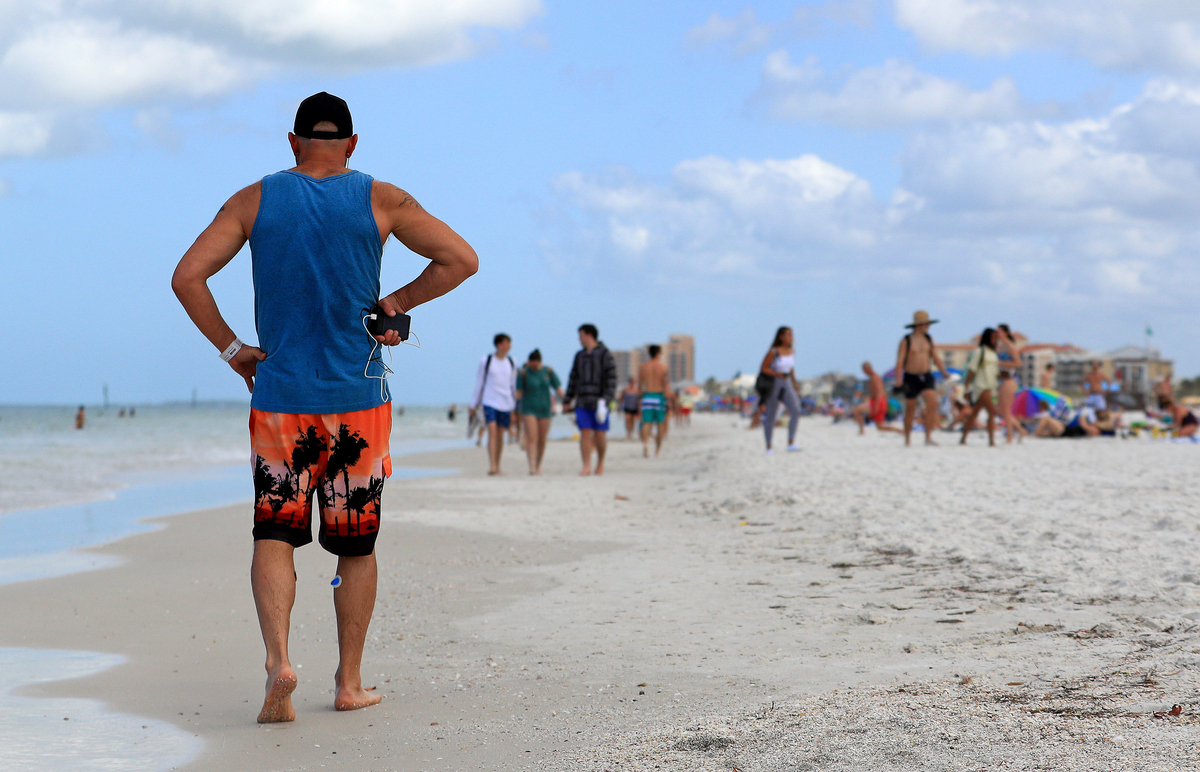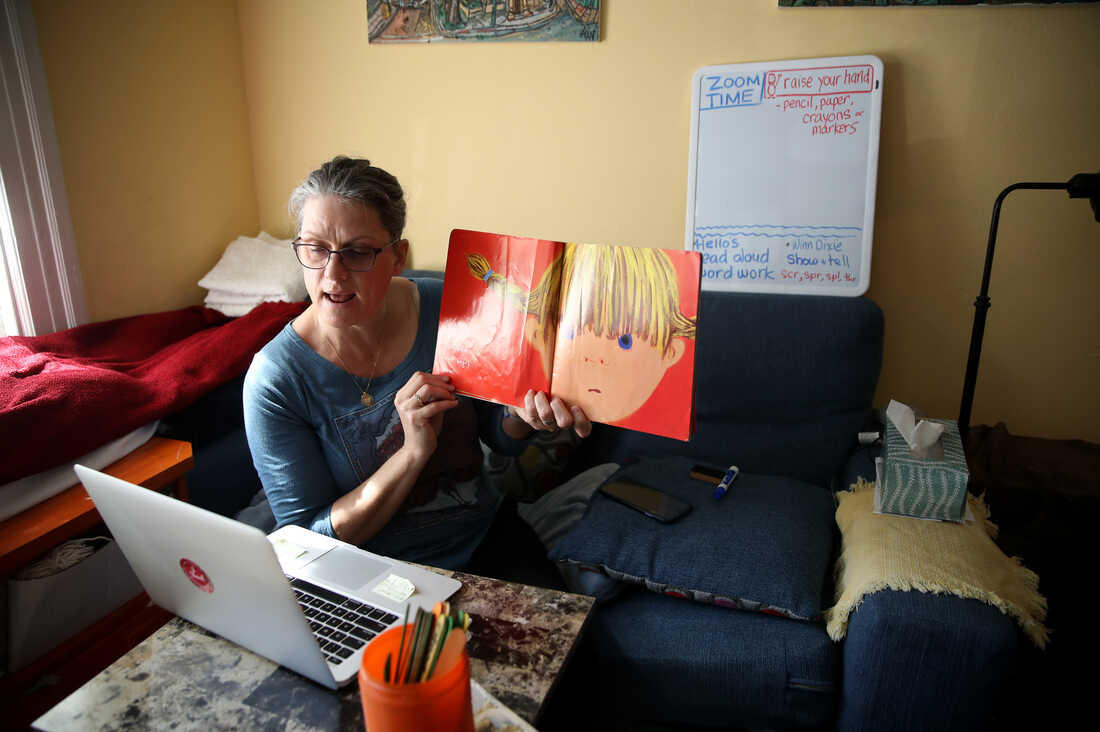Is the Government Gonna Shut Down Again in March

Pedestrians cross South Grand Artery in Downtown Los Angeles even after California Gov. Gavin Newsom issued a statewide stay-at-domicile order on March 19. Apu Gomes/AFP via Getty Images hibernate caption
toggle caption
Apu Gomes/AFP via Getty Images
As coronavirus infections rise across the United States, public health experts widely hold it'due south time for a drastic step: Every state in the nation should now outcome the kind of stay-at-dwelling orders outset adopted by the hardest-striking places. And while most states will probably not demand to keep the rules in place for months upon months, many health specialists say the lockdowns volition need to be kept up for several weeks.
Still amidst these aforementioned experts, at that place is contend when it comes to the natural next question: What strategy can be deployed after the lockdowns are lifted?
Here'southward the breakdown of what health experts are saying about each issue.
The arguments for enacting a lockdown
We'll beginning with the call for a nationwide lockdown. On this signal, "there is no question about information technology," says Juliette Kayyem, a quondam assistant secretary of homeland security who is now faculty chair of the homeland security program at Harvard'due south Kennedy School of Authorities. "We are seeing customs spread in every state. You need the nation to shut down."
In fact, state officials should have taken this action at least 10 days ago, argues Ashish Jha, managing director of the Harvard Global Health Institute, 1 of a number of public health professionals who for weeks have been urging states to be more than aggressive.
"At this point, at that place's really no adept alibi for any state official not to take these policies in effect," says Jha.
He notes that when the virus is left unchecked, information technology infects people at an exponential rate. Each sick person passes it on to something like two to three others — who and then spread it to the next two to 3 people, and then on, such that a single instance speedily leads to thousands.
Social distancing dramatically slows this process by reducing opportunities for people to interact contiguous and infect each other. Evidence from People's republic of china, northern Italy and, near recently, New York — the U.S.'s current hot spot — suggests that even after the virus has spread widely, strict social distancing tin eventually bring the number of new infections downward.
Only, says Jha, "if you wait until the disease is out of control in your community you're going to have to implement those social distancing policies for much, much longer," to stop the upward screw of new infections.
Moreover, adds Jha, "you're still going to have to deal with the fallout of all the people who got very sick and ended upwardly overwhelming the health intendance organization. Many of them will end up dying considering of that delay."
So far xiii states have enacted the strictest combination of restrictions — closures of all nonessential business as well as a prohibition on all gatherings — according to an analysis by the Kaiser Family Foundation.
Many other states accept opted for measures that are weaker — for instance, declining to shut businesses, and limiting their prohibitions on gatherings to groups of more than than 10 or even 50 people. Some states have no statewide limitations whatsoever on either gatherings or business organisation operations other than restaurants. These states include Arizona, Arkansas, Florida, Georgia, North Dakota and Utah.
In several of them, the number of people with positive tests for the coronavirus is relatively low: no more than several hundred, compared with the tens of thousands now infected in New York.

Connecticut'south legislature is suspended until at least April 12 to follow the country's social distancing guidelines. 24-hour interval porter Luis Almenas disinfected all the microphones during a deep clean in the Senate chambers on March 12. Joe Amon/Connecticut Public/NENC hide explanation
toggle explanation
Joe Amon/Connecticut Public/NENC
Anthony Fauci, managing director of the National Institute of Allergy and Infectious Diseases and a cardinal leader of the assistants's COVID-19 response, said, in an interview with NPR on Thursday, that a "compatible" nationwide shutdown is not warranted because of the variation in rates of infection across states.
"I hateful, obviously, you always go on an open mind that you might have to revert to something like that," said Fauci. "Only there are regions of the land where rather than close down, we should be doing ... containment."
Fauci so described a strategy of seeking out and identifying people with symptoms, testing them, isolating those who have the virus and tracing their contacts. Afterward Th, President Trump released a letter to U.Southward. governors stating that his administration would soon be issuing guidelines to determine which states could ease upwardly on social distancing and follow such a containment approach.
This is also essentially the strategy that many public health experts hope the U.S. can ultimately pivot to in areas where the number of infections is low.
But Jha and others maintain that right now, the U.Southward. lacks the testing chapters to practise containment this way. In fact, says Jha, the U.S. is yet and so behind on testing that it'southward impossible to know whether a depression number of official cases in a particular city or state isn't actually masking a brewing hotspot.
In the interview with NPR Fauci conceded that, "to be honest, we don't take all that data now uniformly throughout the country to make those determinations."
In the meantime, wellness experts such equally Jha contend that even places with low numbers of confirmed coronavirus cases should operate on the assumption that there may be a substantial corporeality of manual in their midst that is going undetected.
In Arizona, for instance, more than half of those who take been tested have been found to take the coronavirus. That's a troubling sign, says Jha. "One affair nosotros know is that if more than 10 to 15% of your tests are positive, you are probably non testing enough. You want to be testing a lot of people considering that's how you capture all the positive cases."

Tremaine Fredericks rides a well-nigh empty Staten Island Ferry to Manhattan in New York Urban center. Gov. Andrew Cuomo's "New York Land on Pause" executive order went into event on March 22. Spencer Platt/Getty Images hide explanation
toggle caption
Spencer Platt/Getty Images
Arizona's condition is particularly concerning to Jha because the state has a larger-than-average share of older residents – and the virus kills older people at vastly higher rates.
2 other states with less stringent social distancing rules where the trend also seems worrisome, he says, are Florida and Texas. "These are places that are probable going to finish up seeing big increases in their numbers of very, very sick people. And we'll accept wished that they had taken a interruption much earlier," says Jha.
In Florida more than 300 people have already been hospitalized with COVID-19 – one of the highest totals in the land, according to data compiled past the COVID tracking project, a volunteer group of journalists, scientists, and other data specialists. Yet Florida Gov. Ron DeSantis has resisted calls to issue a statewide shelter-in-place social club fifty-fifty every bit several counties have adopted their own versions.

People connected to gather on Florida beaches such equally Clearwater Embankment after the coronavirus had already started to spread in the U.S. On March 20, the city of Clearwater ordered all its public beaches to close. Equally of Friday, Florida has more than than ii,400 confirmed coronavirus cases and 29 deaths. Mike Ehrmann/Getty Images hide caption
toggle caption
Mike Ehrmann/Getty Images

People connected to gather on Florida beaches such as Clearwater Beach subsequently the coronavirus had already started to spread in the U.S. On March 20, the metropolis of Clearwater ordered all its public beaches to close. As of Friday, Florida has more 2,400 confirmed coronavirus cases and 29 deaths.
Mike Ehrmann/Getty Images
Florida'due south ratio of confirmed coronavirus cases to its overall population also now appears to be at a level similar to that of New York's barely 10 days agone. And this is the case in almost 20 other states too.
So why aren't all states rushing to put their residents under effective lockdown? I reason may exist mixed signals coming from the Trump administration about how necessary or urgent these measures are.
Fauci'due south comments to NPR are but the latest example. On March sixteen, the president issued guidelines urging all Americans to work from home if possible and to avoid gatherings of more than than ten people as well every bit discretionary travel and eating out. But the guidelines were proposed for a period of only xv days — which means they expire on March 31.
In recent press conferences, the president has likewise repeatedly decried the economical and social cost of farthermost social distancing and said he remains hopeful that by Easter — which is April 12 — the measures may no longer be needed in many locations.
Technically, the power to enact social distancing rules lies with state authorities. Only they often have their cues from the federal regime.
Jha, who has been fielding calls from a number of governors weighing tighter restrictions, says another reason for their hesitancy is dubiousness over the end game. "They want to know when can they un-interruption. What are the criteria they're going to be able to use to go back to normal?"
In other words, what is the strategy post-lockdown?
On this point, in that location is a wider range of views among public wellness experts. Hither's a sampling.
Test, trace and isolate
Both Kayyem, the former homeland security official, and Jha stress that farthermost social distancing is a temporary measure. The aim is to keep the number of infections across the Us low while authorities ramp upwardly sufficient infirmary beds and testing capacity to pivot to a stage two strategy that sounds a lot like the "containment" effort Fauci spoke of. At that place would exist widespread testing to identify and isolate positive cases and their contacts. South Korea has demonstrated some success with this model.

Leanne Francis, first-grade teacher at Harvey Milk Civil Rights Academy, conducts an online class on March 20 from her living room in San Francisco. Justin Sullivan/Getty Images hide caption
toggle caption
Justin Sullivan/Getty Images
Kayyem warns that any shift to this approach will likely take place gradually and at a different pace for dissimilar regions. "This does not happen in a day," she says. "The lights don't go on at the aforementioned time everywhere. We have to think of the recovery as much more fluid."
And she adds that fifty-fifty later motion restrictions are lifted, it's probable there will exist flare-ups of COVID-19 infections in particular states or cities. This will require reimposition of extreme social distancing measures at that place, says Kayyem, likening the arroyo to "a game of whack-a-mole."
'We're really in a big dilemma'
Marc Lipsitch, a professor of epidemiology at Harvard, is less optimistic. He says his group's models of how the virus spreads suggest that as soon as a freeze on movement is lifted, cases would rise then rapidly that "nosotros'll spend much more time in freeze mode."
Only he recognizes that this is a problematic decision. It would be devastating to go along large swaths of the country in lockdown for the roughly 18 months information technology'due south expected to take until a vaccine can be adult, he says. And the hurting would not just be economic. The resulting poverty would lead to widespread deprivations and even decease.
On the other hand, says Lipsitch, without broad motion restrictions, tens of thousands and even potentially millions of Americans will die of COVID-xix — non to mention those with other illnesses and health emergencies who may endure because of the breakdown of the wellness intendance system.
"I think the unfortunate fact is that the two options we know nigh are both essentially unacceptable," says Lipsitch. "I call back we're really in a large dilemma."
Take the inevitable and start making the hard choices
Michael Osterholm, director of University of Minnesota's Center for Infectious disease Research and Policy, also worries that a phase two test-and-isolate strategy may not be feasible. But his view stems from his conviction that the U.S. volition never be able to build enough testing capacity.
Osterholm notes that the chemical reagents needed to run coronavirus tests are already in short supply. Over the coming weeks and months, worldwide demand volition only exacerbate the problem.
"We are literally within three to four weeks into the complete implosion of testing in this state," says Osterholm. "And so don't plan an extensive national try around testing, only to find out in a couple of weeks we tin't even do it."
Instead, says Osterholm, the U.Southward. should face up to the likelihood that throughout the entirety of the outbreak, there volition be shortages of not simply testing but besides of most other necessary medical supplies. By failing to acknowledge this reality now, he says, the U.S. is wasting valuable fourth dimension needed to make the hard choices about how to soften the blow when the inevitable wave of cases washes over.
For instance, he says, officials will demand to find less-than-ideal, but creative ways to reduce the need for supplies such as protective equipment for health workers. I option, he says, would be to place infected patients in massive wards such that doctors and nurses don't need to keep putting on and taking off the protective gear.
Osterholm says the U.S. also needs to think of ways to protect the elderly and other populations that are peculiarly vulnerable to the virus, fifty-fifty as we accept that much of the rest of the population will get infected.
He does not discount the difficulty of trying to cocoon elderly people.
"Do I recollect that it volition cease all people from getting infected in that historic period group? No," says Osterholm. "Just I do think that'south our best chance at reducing the number of cases that present to our health care systems."
As unpalatable as all this may sound, says Osterholm, compared with the exam and isolate strategy that others are championing, his arroyo is at least realistic."I don't want the impossible becoming the enemy of the doable," he says, "and I think that that's where nosotros're at right now."
But similar so many other public wellness experts, Osterholm likewise, argues that a nationwide freeze is absolutely necessary right at present.
It's the but way, he says, that the U.S. tin can buy enough time to put in place a plan for the onslaught that'southward coming.
Source: https://www.npr.org/sections/health-shots/2020/03/27/822146372/experts-say-the-u-s-needs-a-national-shutdown-asap-but-differ-on-what-comes-next
0 Response to "Is the Government Gonna Shut Down Again in March"
ارسال یک نظر